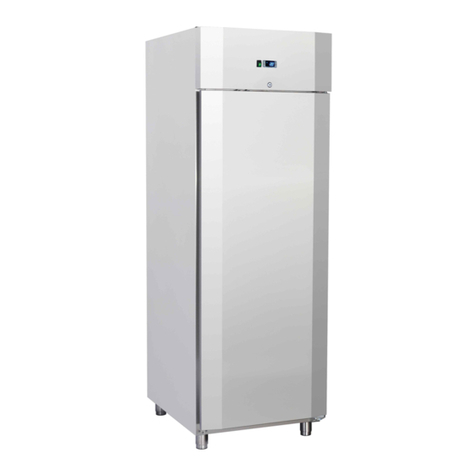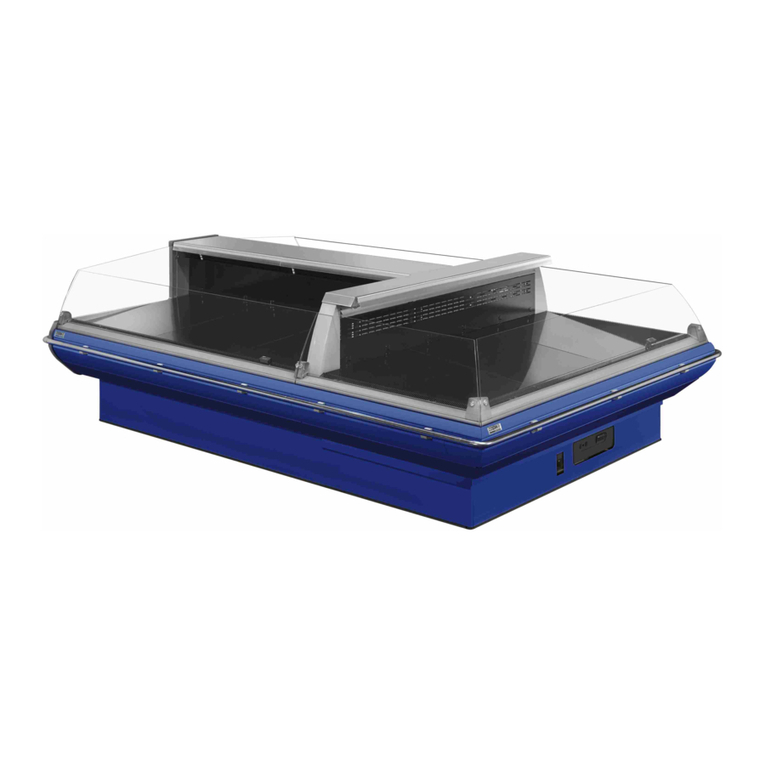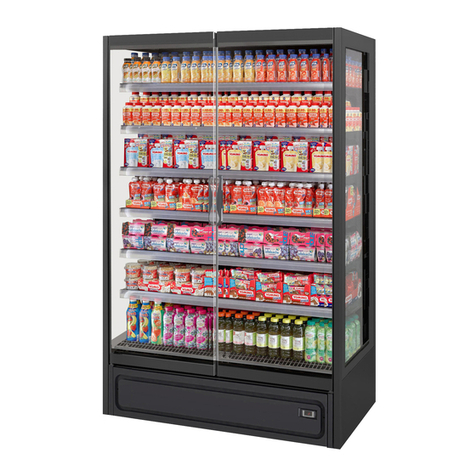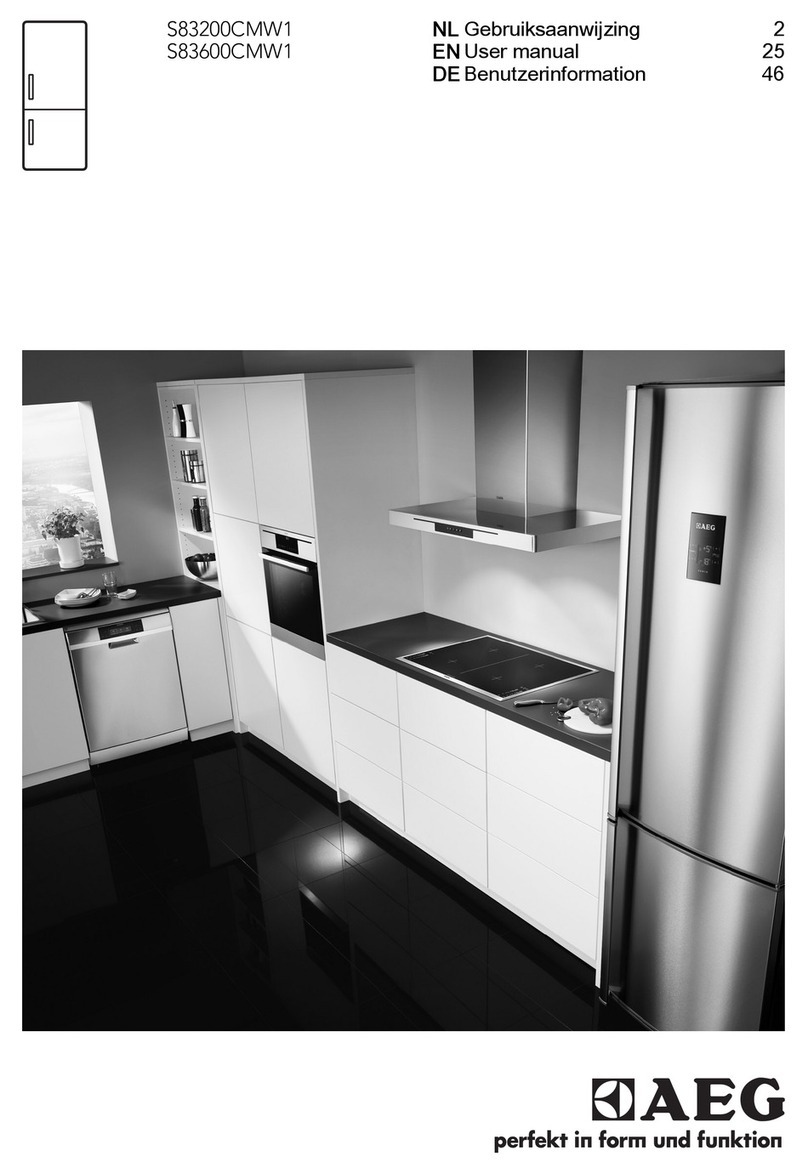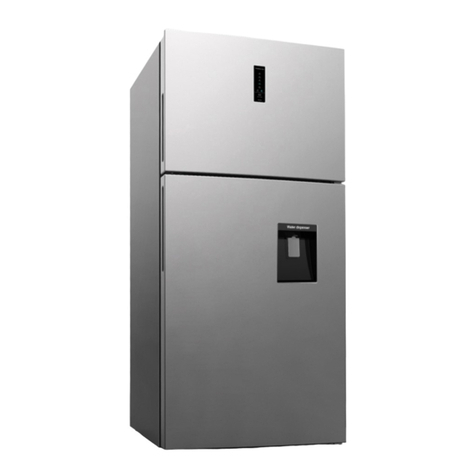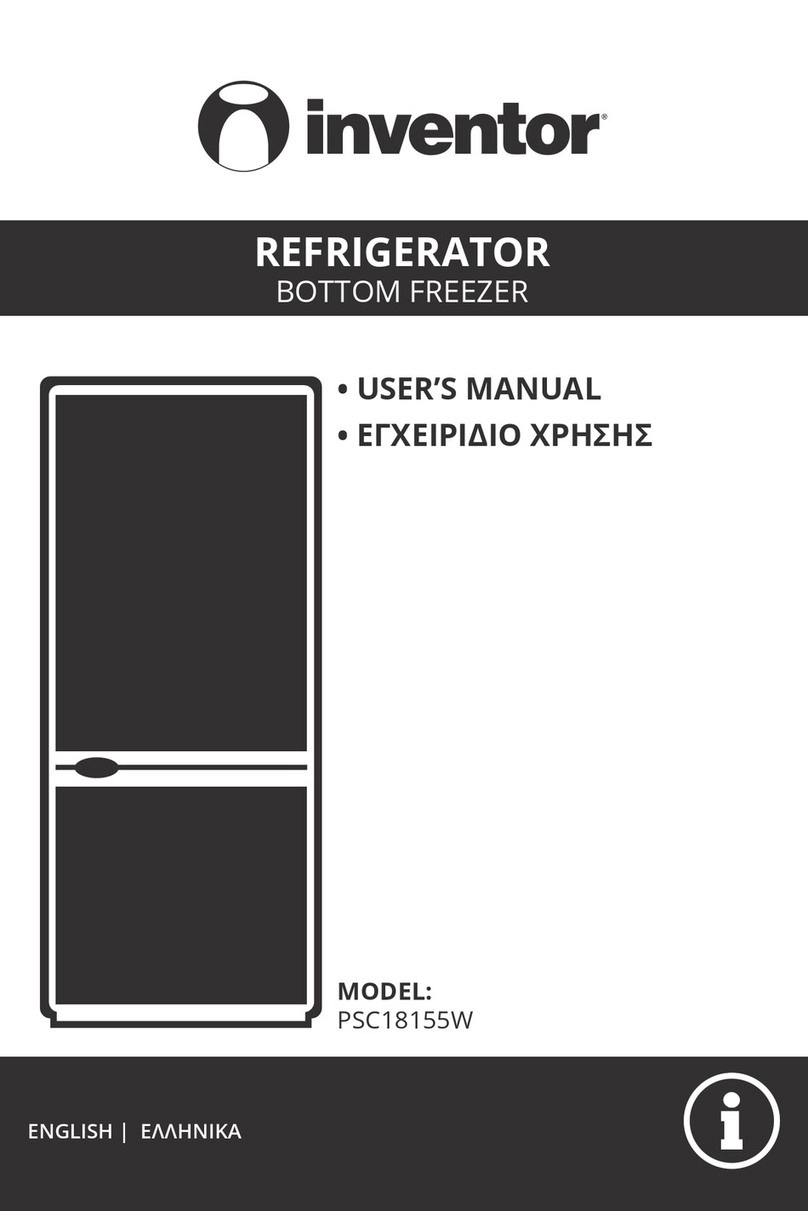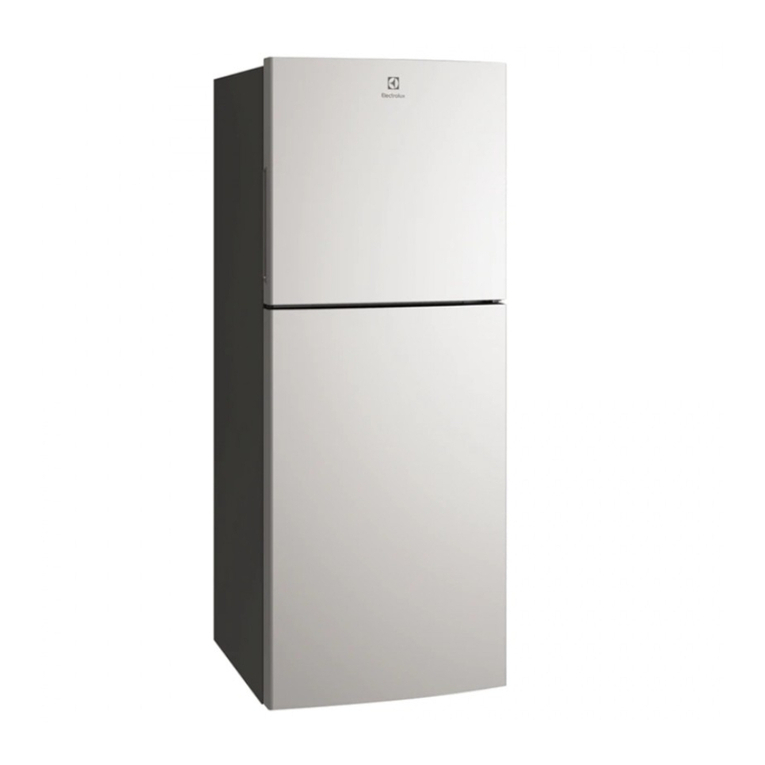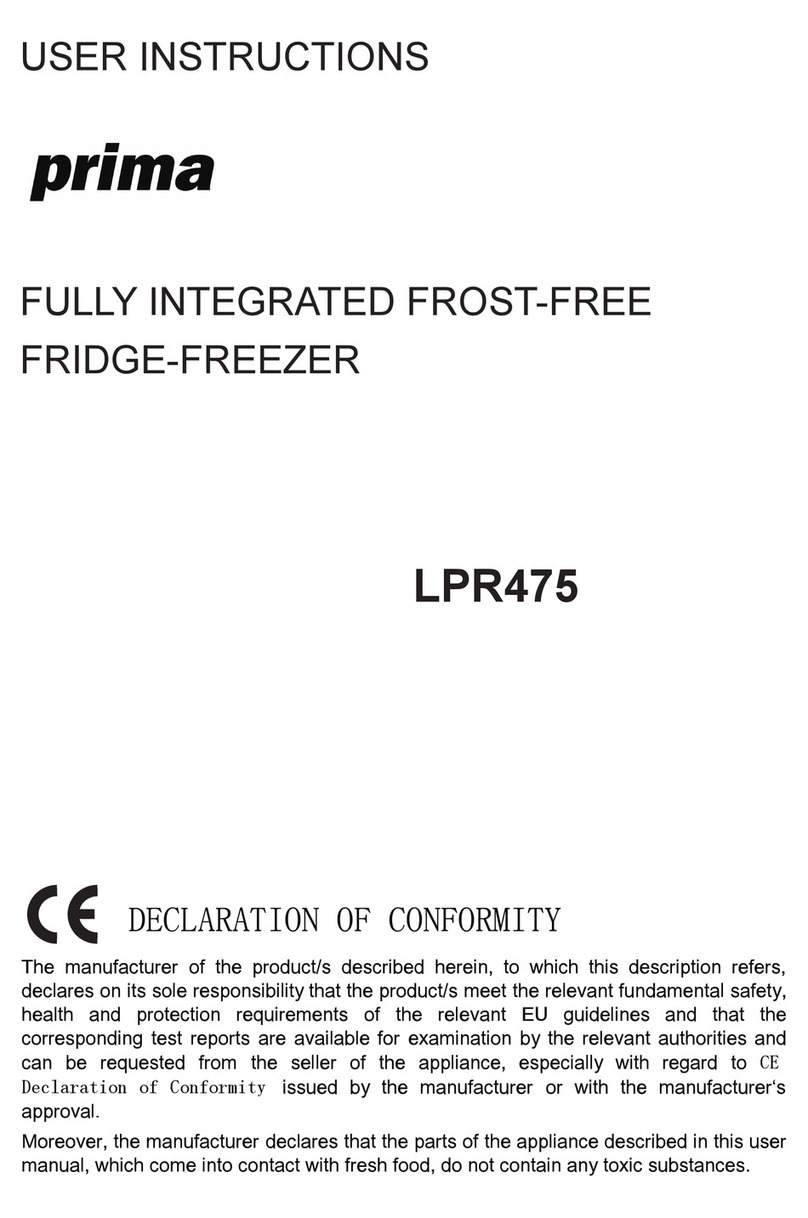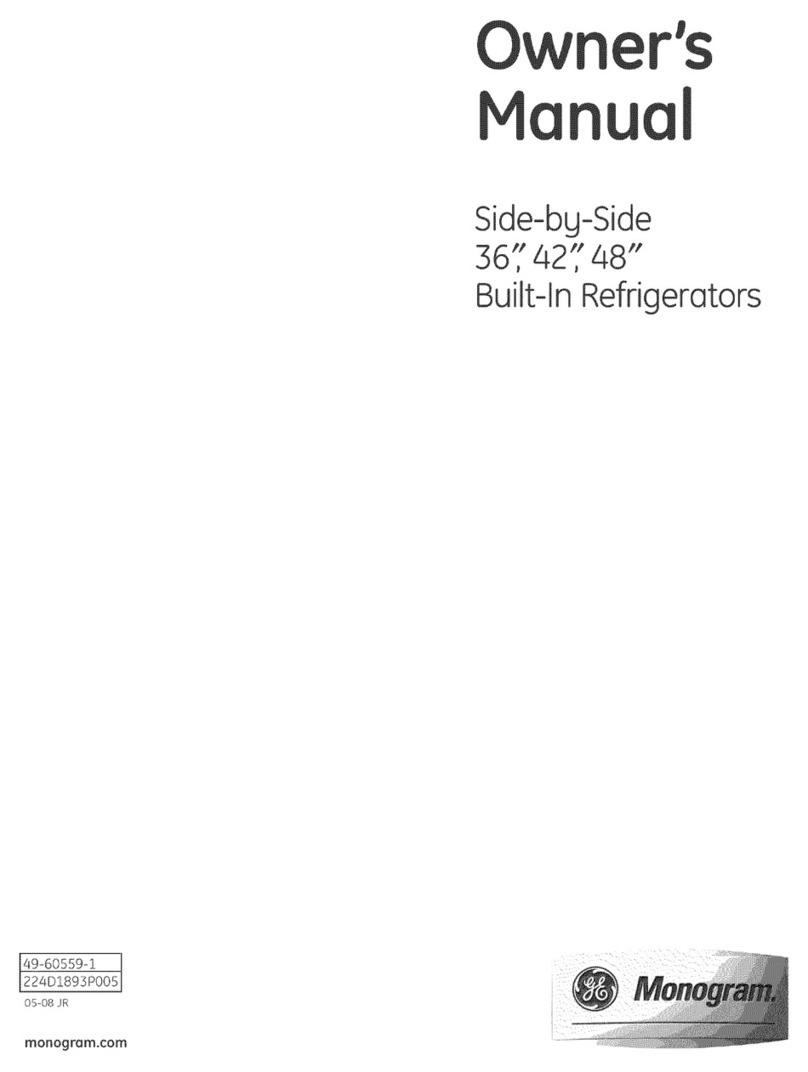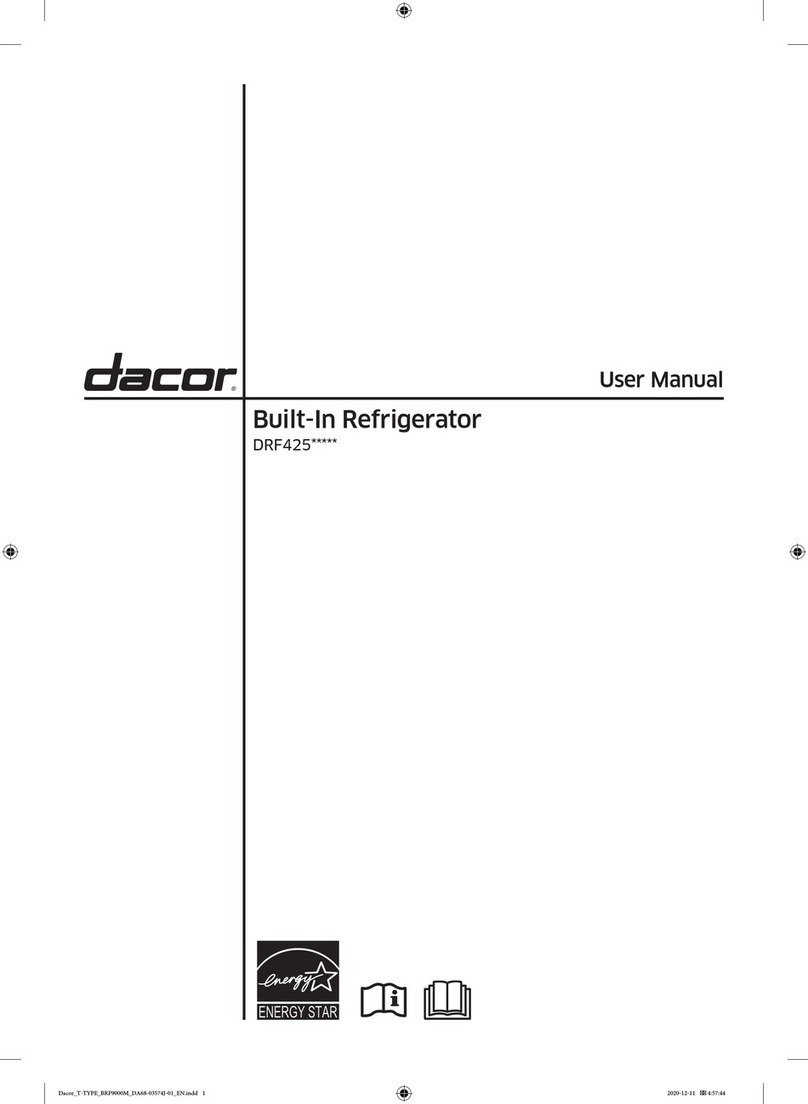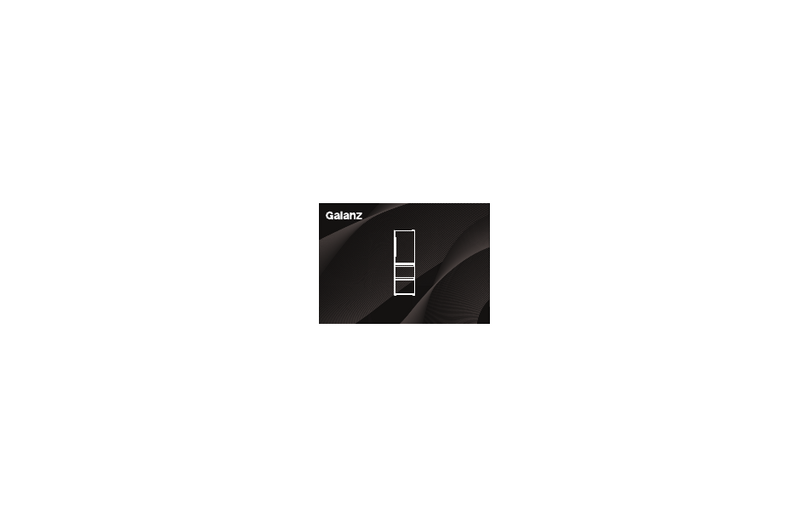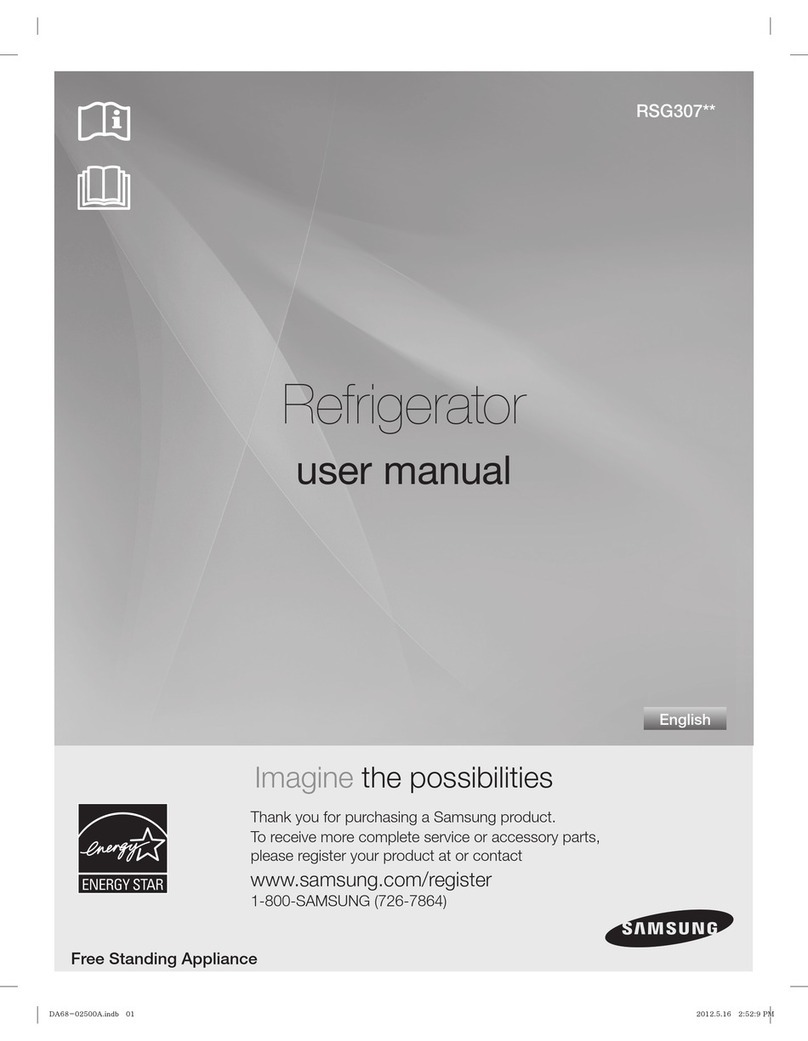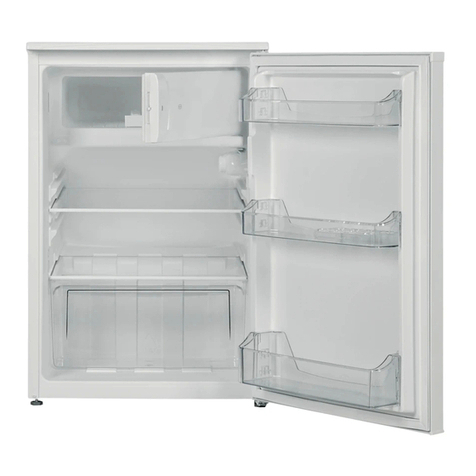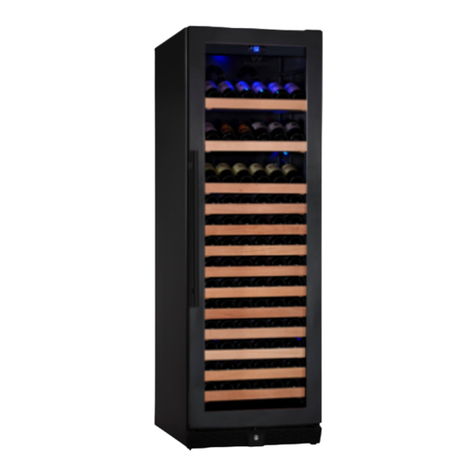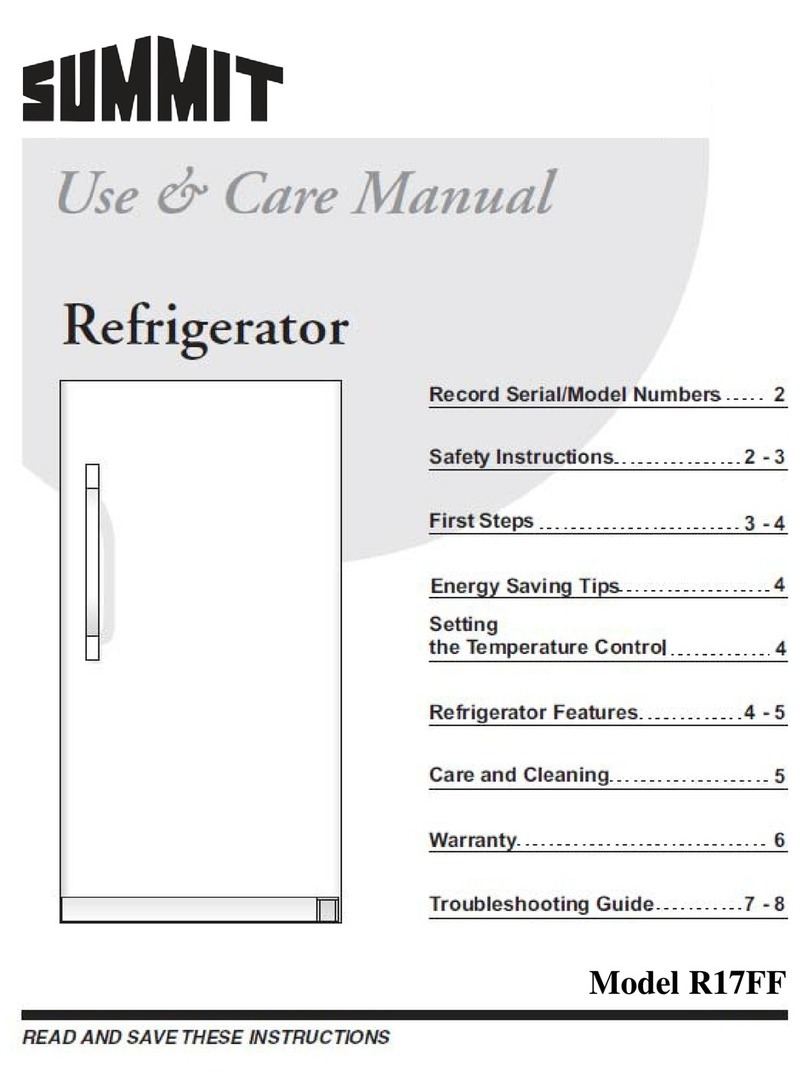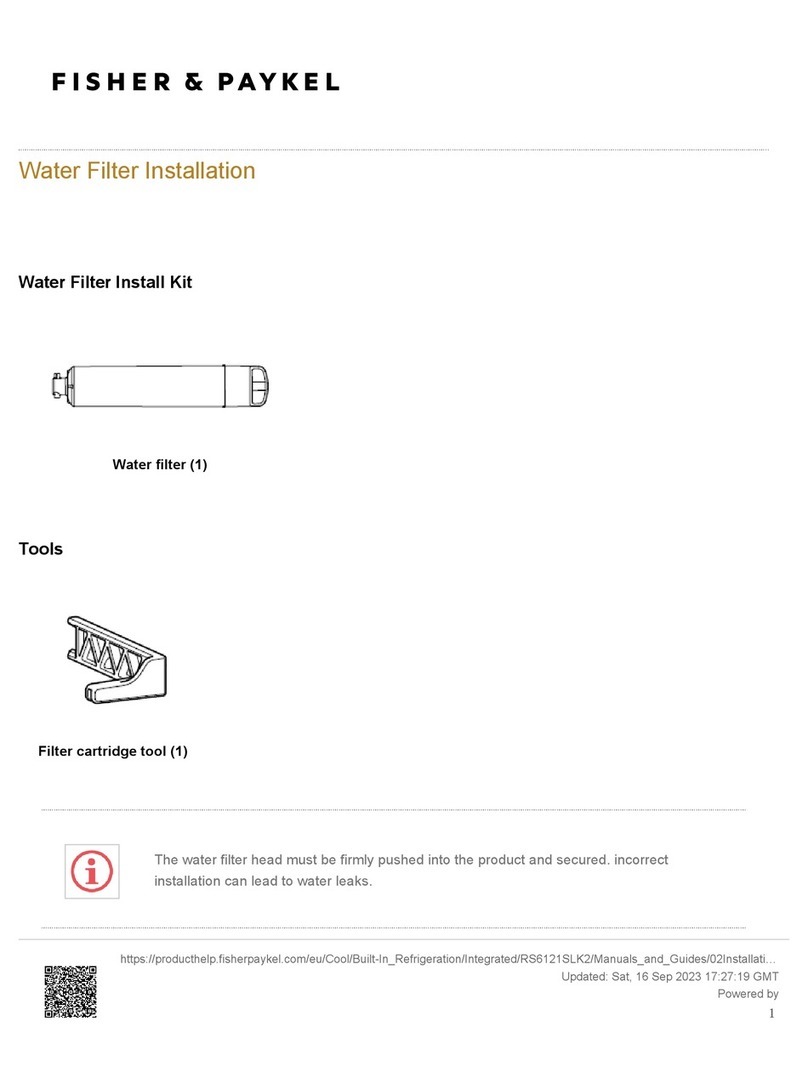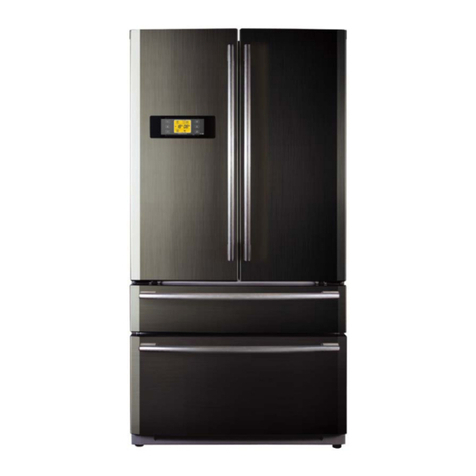EPTA iarp Ab 500 P User guide

Cod. UM000098
ISTRUZIONI PER L'USO E LA MANUTENZIONE
USE AND MAINTENANCE
INSTRUCTIONS D'EMPLOI ET D'ENTRETIEN
GEBRAUCHS-UND BEDIENUNGS ANLEITUNGEN
INSTRUCCIONES DE EMPLEO Y MANUTENCIÓN
INSTRUCTIES VOOR HET GEBRUIK EN HET ONDERHOUD
ARMADIO PROFESSIONALE
SERVICE CABINET
ARMOIRE PROFESSIONNELLE
BERUFS-KÜHLSCHRANK
ARMARIO PROFESIONAL
PROFESSIONELE KOELKAST
Rev.A del 12/07/2016

-2-

-3-

-4-
- ISTRUZIONI ORIGINALI -
INFORMAZIONI PER L’UTILIZZATORE
AVVERTENZA PER GLI APPARECCHI
CHE UTILIZZANO REFRIGERANTE R290
(PROPANO)
Il propano è un gas naturale senza effetti sull’ambiente,
ma inammabile.
E’quindi indispensabile accertarsi che tutti i tubi del circuito refrigerante
non siano danneggiati, prima di collegare l’apparecchio alla rete di
alimentazione.
Ogni 8 gr. di refrigerante, il locale d’installazione deve disporre di un
volume minimo di 1 m³.
La quantità di refrigerante dell’apparecchio è indicata sulla targa dati
tecnici dell’apparecchio.In caso di perdita di refrigerante, evitare che
amme libere o fonti di accensione vengano a trovarsi in prossimità
del punto di fuga. Fare attenzione a non danneggiare le tubazioni del
circuito refrigerante durante il posizionamento, l’installazione e la
pulizia. Evitare fuochi o scintille all’interno dell’apparecchio.
Attenzione! Non danneggiare il circuito refrigerante.
Attenzione!Non danneggiare le pareti interne o esterne dell’apparecchio:
il circuito del uido refrigerante potrebbe danneggiarsi. In caso di
pareti danneggiate non avviare l’apparecchio e rivolgersi ad un centro
assistenza.
Attenzione! In caso di circuito del uido refrigerante danneggiato non
avviare l’apparecchio e rivolgersi ad un centro assistenza.
Attenzione! Mantenere libere da ostruzioni le aperture di ventilazione
nell’involucro dell’apparecchio o nella struttura a incasso.
Attenzione!Non utilizzare apparecchielettriciall’internodegliscomparti
dell’apparecchio per la conservazione dei cibi congelati se questi non
sono del tipo raccomandato dal costruttore.
Attenzione! Non conservare sostanze esplosive, quali contenitori sotto
pressione con propellente inammabile, in questo apparecchio.
ITALIANO

-5-
INDICAZIONI DI SICUREZZA
•Leggete attentamente il manuale e rispettate i contenuti prima di
installare ed utilizzare l’apparecchio.
• Conservate sempre il libretto d’istruzione e in caso di vendita
dell’apparecchio consegnatelo al nuovo proprietario.
• Questo apparecchio è molto pericoloso se lasciato esposto alla pioggia,
ai temporali ed alle intemperie con il cavo di alimentazione inserito alla
presa di corrente.
• I bambini devono essere sorvegliati per asssicurarsi che non giochino con
l’apparecchio.
• Non toccate né manovrate mai l’apparecchio a piedi nudi o con le mani
e i piedi bagnati.
• Gli elementi dell’imballo quali sacchetti di plastica, polistirolo, fascette
plastiche, non devono essere lasciati alla portata dei bambini in quanto
potenziali fonti di pericolo.
• Non permettete che i bambini giochino con l’apparecchio es. sedendosi
nei cestelli o dondolandosi o aggrappandosi ai coperchio, il conservatore
potrebbe ribaltarsi, oppure potrebbero cadere eventuali oggetti posti sulla
sua sommità.
• Dopo aver installato l’apparecchio assicuratevi che non poggi sul cavo
d’ alimentazione.
• Per staccare l’apparecchio dalla rete di alimentazione estraete la spina.
Non tirate il cavo di alimentazione di quest’ultima.
• Concircuitorefrigerantedanneggiato ènecessarioassolutamentespegnere
le luci.
• Non conservare sostanze esplosive, quali contenitori sotto pressione con
propellente inammabile, in questo apparecchio.

-6-
MOVIMENTAZIONE
L’unità viene spedita ancorata su base in legno e
protetta da montanti angolari ,cappello in cartone
e da involucro in nylon.
La movimentazione va effettuata esclusivamente
mediante carrello elevatore di potenza adeguata
al peso dell’apparecchio.
E’ da evitare in maniera assoluta il posizionamento
dell’apparecchio orizzontalmente, o su un anco
o capovolto.
Il frigorifero deve rimsnere verticale.
INSTALLAZIONE
Apparecchio adatto alla conservazione di alimenti confezionati.
Dopo aver tolto l’imballo procedere ad una pulizia accurata di tutto il banco, utilizzando acqua tiepida
e sapone neutro al 5% ed asciugandolo poi con un panno morbido.
La distanza dal muro deve essere di almeno di 10 cm.
Regolare i piedini rispetto al piano di appoggio
dei rullini.
Sistemare l’apparecchio in piano lontano da fonti
di calore, non esposto ai raggi del sole.
E’ indispensabile che il gruppo condensatore sia
in condizione di libero scambio d’aria; pertanto le
griglie di aerazione non devono essere ostruite da
scatole o altro.
Non sistemare l’apparecchio all’aperto e non esporlo
alla pioggia.
Non usare apparecchi elettrici nel vano
refrigerato.
L’apparecchio non è idoneo a sopportare
rovesciamenti di liquido sulla sommità dello
stesso.
Perquestononappoggiareo collocarecontenitori
di liquidi immediatamente al di sopra del banco
frigorifero.
Installare e posizionare l’apparecchio in modo
che la spina di alimentazione sia facilmente
accessibile.
L’APPARECCHIO NON E’ IDONEO PER
INSTALLAZIONE IN AMBIENTI CON
PERICOLODIINCENDIOODI ESPLOSIONE
O SOTTOPOSTI A RADIAZIONI.
10 cm

-7-
Le condizioni ambientali esterne per un regolare
funzionamento dell’apparecchio sono indicate
sulla targhetta dati tecnici.
Durante i trasporti inserire sotto la porta
l'apposito tassello in legno atto ad evitare
possibili cedimenti del telaio.
MESSA IN SERVIZIO
Accertarsi che la tensione indicata sulla
targhetta dati tecnici corrisponda a quella
di rete.
LA LINEA DI ALIMENTAZIONE
ELETTRICA A CUI SARA’
ALLACCIATO IL FRIGORIFERO DEVE ESSERE
PROTETTA DA INTERRUTTORE DIFFERENZIALE
MAGNETOTERMICO AD ALTA SENSIBILITA’ (In=16
A, Id = 30 mA) E COLLEGATO ALL’ IMPIANTO
GENERALE DI TERRA.
Lamessaaterra ènecessariaed obbligatoriaperuncorretto
funzionamento dell’ apparecchio.
Peril collegamentonon utilizzareassolutamente riduzioni,
prolunghe, adattatori o prese multiple.
Il collegamento deve avvenire pertanto in maniera
DIRETTA alla rete di alimentazione.
Il fabbricante declina ogni responsabilità per eventuali danni
causati a persone o cose derivanti dalla mancata osservanza
di questa norma.
CLASSE CLIMATICA TEMPERATURA AMBIENTE DI FUNZIONAMENTO
0 20
1 16
2 22
3 25
4 30
627
5 40
7 35
8 23,9

-8-
MANUTENZIONE PERIODICA
Qualsiasiintervento effettuatosull’apparecchiodaparte
dell’utente richiede assolutamente il distacco della spina
dalla presa di corrente.
Ispezionare periodicamente il cavo di alimentazione per
controllare se danneggiato.
Se il cavo di alimentazione è danneggiato, non utilizzare
l’apparecchio e tentarne la riparazione: esso deve essere
sostituito dal costruttore o dal suo servizio assistenza o,
comunque, da una persona con qualica similare, in modo
da prevenire ogni rischio.
Nessuna protezione (griglia o carter) va rimossa da parte
di personale non qualicato ed evitare assolutamente di far
funzionare l’apparecchio con tali protezioni rimosse.
Staccare
la spina
Per una buona conservazione delle superci dell'apparecchio operare come segue:
MOBILE ESTERNO: Quando è necessario pulire delicatamente il mobile esterno usare un panno
morbido imbevuto di soluzione di acqua e detersivo neutro.
SUPERFICIINACCIAIO INOSSIDABILE: Lavare con acqua tiepida e detersivi neutri ed asciugare
con panno morbido; evitare pagliette o lana di acciaio che possono deteriorare le superci.
SUPERFICI IN MATERIALE PLASTICO: Lavare con acqua e detersivi neutri, sciacquare ed
asciugare con panno morbido; evitareassolutamentel'usodi alcool,acetoneesolventi chedeteriorano
permanentemente le superci.
UTILIZZO STAGIONALE
Quando la macchina rimane inattiva per lunghi periodi di tempo occorre effettuare le seguenti operazioni
preliminari:
- togliere la spina dalla presa di corrente;
- pulire bene ed asciugare l’apparecchio;
- lasciare leggermente aperta la porta per evitare la formazione di cattivi odori.
- coprire l’apparecchio con un telo, posizionandolo in luogo asciutto e riparato dagli agenti atmosferici
esterni.
ELIMINAZIONE
L’apparecchio contiene olio, gas refrigerante inammabile, parti in plastica, parti metalliche
e vetro.
Attenzione! L’isolamento poliuretanico utilizza come espandente CICLOPENTANO, una sostanza
senza effetti sull’ambiente, ma inammabile. Per garantire la massima cura per gli aspetti ambientali
all’atto della demolizione si raccomanda di non abbandonare mai l’apparecchio nell’ambiente.
Non gettate l’imballo dell’apparecchio nella spazzatura bensì selezionate i vari materiali quali: poli-
stirolo, cartone,sacchi di plastica.
La demolizione dell’apparecchio ed il recupero dei materiali componenti deve avvenire nel rispetto
delle locali normative vigenti in materia.

-9-
SBRINAMENTO E PULIZIA VASCA (AB N)
Per ottenere sempre il massimo rendimento dell’ impianto frigorifero si consiglia uno sbrinamento
manuale quando lo spessore di brina in vasca supera i 5 mm; procedere nel modo seguente:
1) Togliere il prodotto dalla vasca e riporlo in un conservatore a -18°C.
2) Spegnere l’ apparecchio premendo l’interruttore generale (vedi quadro comandi) e staccare la spina.
3) Sui modelli negativi introdurre un catino d’acqua calda ma non bollente all’ interno della vasca
appogiandolo su un foglio di cartone, chiudere la porta ed attendere circa mezz’ora.
4) Procedere all’ operazione di lavaggio e asciugatura della vasca interna con un panno utilizzando
detersivi neutri.
5) Riaccendere il gruppo, ed aspettare che l’apparecchio vada in temperatura prima di caricare
il prodotto.
Attenzione! Non usare getti d’acqua nelle operazioni di pulizia: si possono
danneggiare le parti elettriche.
Attenzione! Non usare dispositivi meccanici o altri mezzi per accelerare il
processo di sbrinamento, diversi da quelli raccomandati dal costruttore.
PULIZIA VASCA (AB P)
Per le operazioni di pulizia della vasca procedere come segue:
1) Mettere il prodotto in apposito contenitore refrigerato alla stessa temperatura e togliere i ripiani.
2) Staccare la spina.
3) Lasciare la porta aperta ed aspettare che la temperatura interna sia uguale a quella ambiente.
4) Procedere all’ operazione di lavaggio ed asciugatura della vasca interna con un panno utilizzando
detersivi neutri.
Successivamente, riattivare l’ apparecchio ed aspettare che vada in temperatura prima di riempirlo
nuovamente.
Attenzione! Non usare getti d’acqua nelle operazioni di pulizia: si possono
danneggiare le parti elettriche.
Attenzione! Non usare dispositivi meccanici o altri mezzi per accelerare il
processo di sbrinamento, diversi da quelli raccomandati dal costruttore.
INFORMAZIONI PER IL SERVIZIO ASSISTENZA
PULIZIA DEL CONDENSATORE
Procedere periodicamente alla pulizia del condensatore alettato o statico da
impurità (polveri e detriti) che si accumulano tra le alette e la supercie frontale
o tra i li ed i tubi ostacolando una buona circolazione dell'aria.
Un condensatore sporco inuisce negativamente sulla resa dell'impianto,
facendone scadere le prestazioni e determinando inutili consumi di energia
elettrica.
L'operazione di pulizia va eseguita con spazzole di setola o, ancora meglio,
con aspiratore.

-10-
INCONVENIENTI E RIMEDI
Gli inconvenienti di funzionamento che si riscontrano negli apparecchi frigoriferi sono dovuti, nella
maggioranza dei casi, a cause banali o ad installazione elettrica difettosa. Si tratta quindi di cause che
possono essere facilmente eliminate sul postonico.
L'apparecchio non funziona:
- controllare che la corrente arrivi regolarmente alla presa;
- controllare che la spina sia bene inserita nella presa.
La temperatura interna non è sufcientemente bassa:
- controllare che l'apparecchio non si trovi vicino ad una fonte di calore;
- controllare che non vi sia un eccessivo accumulo di ghiaccio sulle pareti della vasca;
- controllare la regolazione della temperatura;
- controllare che sul retro dell'apparecchio vi sia spazio sufciente per la circolazione dell'aria;
L'apparecchio è rumoroso:
- controllare che tutte le viti ed i bulloni siano ben serrati;
- controllare che l'apparecchio sia ben livellato;
- controllare che qualche tubo o pala dei ventilatori non sia in contatto con altre partidell'apparecchio.
AVVERTENZE PER IL CORRETTO SMALTIMENTO DEL
PRODOTTOAI SENSI DELLADIRETTIVAEUROPEA2002/96/
EC
Alla ne della sua vita utile il prodotto non deve essere smaltito insieme ai riuti urbani.
Può essere consegnato presso gli appositi centri di raccolta differenziata predisposti dalle
amministrazioni comunali, oppure presso i rivenditori che forniscono questo servizio.
Smaltire separatamente un elettrodomestico consente di evitare possibili conseguenze
negative per l’ambiente e per la salute derivanti da un suo smaltimento inadeguato e
permette di recuperare i materiali di cui è composto al ne di ottenere un importante
risparmio di energia e di risorse.
Per rimarcare l’obbligo di smaltire separatamente gli elettrodomestici, sul prodotto è
riportato il marchio del contenitore di spazzatura mobile barrato.

-11-
- ORIGINAL INSTRUCTIONS -
INFORMATION ABOUT USE
SAFETY WARNINGS FOR THE APPLIANCES
USING R290 COOLING FLUID (PROPANE)
Propane is a natural gas that doesn’t affect the environment
but is inammable. It is therefore indispensable to check
that the cooling circuit tubing is not damaged before con-
necting the equipment to the mains.
For every 8gr. of cooling uid, the installation location must have a
minimum volume of 1 cubic metre.
The amount of cooling uid in the appliance is indicated on the technical
data plate in the tank.
Leakage of cooling uid: avoid naked ames or over sources of ignition
at the seat of the leakage.
Be careful not to damage the cooling uid circuit during positioning ,
installation or cleaning. Avoid ames or sparks inside the equipment.
Warning! Do not damage the cooling uid circuit
Warning! Do not damage internal or external walls of the machine:
the cooling uid circuit may damage. In case of damaged walls do not
start the machine and refer to a service centre.
Warning! In case of damaged cooling uid circuit, do not start the
machine and refer to a service centre.
Warning! Keep clear of obstruction all ventilation openings in the
appliance enclosure or in the structure for building-in.
Warning! Do not use electrical appliances inside the food storage com-
partments of the appliance, unless they are of the type recommended
by the manufacturer.
Warning! Do not store explosive substences such as aerosol cans with
ammable propellant in this aplliance.
ENGLISH

-12-
SAFETY INFORMATION
•Read themanualcarefullyandadheretothe contentsbefore installing
and using the appliance.
• Always keep the instructions manual safe and if the appliance is sold,
hand it over to the new owner.
• This equipment is very dangerous if left exposed to rain, thunderstorms
or bad weather with the power cable plugged into the power socket.
• Do not ever touch or handle the appliance with bare feet or with wet hands
and feet.
• The children must be supervised to ensure that they do not play with the
appliance.
• The packaging materials, such as plastic bags, polystyrene, plastic cable
ties, must not be left in reach of children as they are potential sources of
danger.
• Do not let children play with the appliance e.g. sitting in the baskets or
rocking on or holding the cover, the cooler may overturn, or any items
placed on top of it may fall down.
• After installing the appliance make sure that it is not positioned on the
power cable.
• To disconnect the appliance from the mains, take out the plug. Do not pull
the power cable out of it.
• If the coolant circuit is damaged, it is strictly necessary to turn off the lights.
• Do not store explosives, such as pressurized containers with ammable
propellant, in this appliance.

-13-
HANDLING
The unit is shipped anchored onto a wooden
base and protected by corner posts, cardboard
top and nylon wrapping.
It must only be handled using a fork lift truck
with adequate power to the load.
Positioning the appliance horizontally or on its
side or upside down is to be strictly avoided.
The equipment MUST be kept vertical.
INSTALLATION
Appliance suitable for packaged foodstuff preservation.
After unpacking, thoroughly clean the entire bench with warm water and 5% mild soap and then
dry it with a soft cloth.
The distance from the wall should be at least 10 cm.
Adjust the feet with respect to the support plane
of the rollers.
Position the appliance on a level surface away
from heat sources that is not exposed to sunlight.
It is essential for the condenser unit to be able to
exchange air freely; therefore, the air grills must
not be obstructed by boxes or anything else.
Do not position the appliance outdoors or expose
it to rain.
Do not use electrical appliances in the
refrigerated compartment.
Theappliance isnotsuitabletowithstandspills
of liquid on top of it.
Therefore, do not rest orplace containers with
liquids immediately above the refrigerated
cabinet.
Install and position the appliance so that the
power plug is easily accessible.
THE APPLIANCE IS NOT SUITABLE FOR
INSTALLATIONINAREASWITHDANGER
OF FIRE OR EXPLOSION OR EXPOSED
TO RADIATION.
10 cm

-14-
The external environmental conditions for the
appliance to run smoothly are indicated on the
rating plate.
During transports operation put the wood part
under the door in order to avoid possible door-
frame foldings.
COMMISSIONING
Make sure that the voltage on the rating plate
corresponds to the mains voltage.
THE MAINS POWER LINE THAT
THE REFRIGERATED CABINET
WILL BE CONNECTED TO MUST
BE PROTECTED BY A HIGH SENSITIVITY CIRCUIT
BREAKER (In=16 A, Id=30 mA)AND CONNECTED TO
THE MAINS EARTHING SYSTEM.
The earthing is necessary and mandatory for the appliance
to work properly.
For the connection, never use reductions, extension cords,
adapters or multiple sockets.
The connection must therefore be made DIRECTLY to the
mains power supply.
The manufacturer accepts no responsibility for any damage
caused to persons or property resulting from failure to observe
this rule.
CLIMATE CLASS ENVIRONMENT OPERATING TEMPERATURE
0 20
1 16
2 22
3 25
4 30
627
5 40
7 35
8 23,9

-15-
PERIODIC MAINTENANCE
Any work carried out on the appliance by the user
strictly requires the power plug being disconnected
from the mains socket.
Inspect the power cable to see if it is damaged.
If the power cable is damaged, do not use the appliance and
try to repair it: it must be replaced by the manufacturer or
its customer service department or by a similarly qualied
person, in order to prevent any risks.
No protection (grill or guard) should be removed by
unqualied personnel and strictly avoid operating the
appliance with these protections removed.
Unplug
the unit
For a good preservation of the cabinet’s body a periodical cleaning is necessary.
EXTERNALBODY: When necessary, the external body should be cleaned with a cloth and a neutral
soap and water solution.
STAINLESS STEELSURFACES: wash with warm water and mild detergent, rinse well and dry with
soft cloth. Avoid scouring pads etc. which will spoil the nish of the stainless steel.
SURFACES IN PLASTIC MATERIAL: wash with warm water and mild detergent, rinse well and
dry with soft cloth; under no circumstances should alcohol, methylated spirits or solvents be used.
SEASONAL WORK
When the unit is kept unused for a long time, please take note of the following procedures:
- unplug the unit;
- clean and dry well the tank;
- leave the door open to avoid possible formation of bad smells;
- cover the unit with a curtain, place it in a dry room and sheltered from the atmospheric agents.
ELIMINATION
The appliance contains oil, ammable coolant gas, plastic parts, metal and glass parts.
Warning! The polyurethane insulation uses a ammable substance with low environmental impact as
a CYCLOPENTANE blowing agent. To ensure the utmost attention to the environmental, at the time
of the demolition, it is recommended to abandon the appliance.
Do not throw away the packaging of the appliance in the rubbish but rather pick out the different
materials, such as styrofoam, cardboard, plastic bags. The appliance and the recovery of the component
materials must be demolished in accordance with local regulations in force.

-16-
DEFROSTING AND CLEANING THE TANK (AB N)
To always get the best performance out of the refrigeration system, a manual defrost is recommended
when the thickness of the frost in the tank is greater than 5 mm; proceed as follows:
1) Remove the product from the tank and store it in a cooler at -18°C.
2) Turn the appliance off at the mains switch (see control panel) and unplug it.
3) On negative models, pour a basin of warm but not boiling water inside of the tank, placing it on a
sheet of cardboard, close the door and wait for about half an hour.
4) Proceed to the washing and drying of the inner tank with a cloth using neutral detergents.
5) Turn the unit back on and wait for the appliance to reach the correct temperature before
loading the product.
Warning! Do not use water jets for cleaning: this can damage the electrical
parts.
Warning! Do not use mechanical appliances or other means to speed up the
defrosting process, other than those recommended by the manufacturer.
CLEANING THE TANK (AB P)
For the tank cleaning operations, proceed as follows:
1) Put the product in a special refrigerated container at the same temperature and remove the shelves.
2) Unplug IT.
3) Leave the door open and wait until the internal temperature matches the ambient temperature.
4) Proceed to the washing and drying of the inner tank with a cloth using neutral detergents.
Then turn unit back on and wait for it to reach the correct temperature before relling it.
Warning! Do not use water jets for cleaning: this can damage the electrical
parts.
Warning! Do not use mechanical appliances or other means to speed up the
defrosting process, other than those recommended by the manufacturer.
INFORMATIONS ABOUT SERVICE
CONDENSER CLEANING
Remove periodically from the condenser unit ventilated or static the impurity
(dust and deposit) which remain among the ns of the condenser, obstructing
a good circulation of the air. A dirty condenser reduces the performance of the
equipment, increasing the energy consumption. Cleaning should be carried out
with a soft brush or preferably with a vacuum cleaner.

-17-
MALFUNCTIONS AND REMEDIES
Most of the functioning inconveniences are generally due to simple causes or to defective electrical
connections. These problems can usually be solved on the place .
The unit does not start:
- check that there is voltage at the wall socket;
- check that the unit is properly plugged.
The internal temperature is not cold enough:
- check that the unit is not placed too close to any heating source;
- check that there is not too much ice on tank walls;
- check the temperature setting ;
- check that behind the cabinet air can properly circulate;
The unit is noisy:
- check that all the bolts and nuts are properly fasten;
- check that the unit is placed on an even surface;
- check if any pipe or fan is in contact with any other part of the body.
INFORMATION FOR THE CORRECT DISPOSAL OF THE
PRODUCT INACCORDANCE WITH EC DIRECTIVE 2002/96/
EC
At the end of its useful life, the product must not be disposed of as urban waste.
It can be taken to a special waste collection centre licensed by the local authorities or
to a dealer that provides this service.
Disposing of the household appliance separately prevents possible negative consequences
for the environment and for health as a result of inappropriate disposal and allows
recover the materials it is made of to be recovered for signicant savings in energy
and resources. As a reminder of the obligation to dispose of household appliances
separately, the product is marked with a crossed out waste bin.

-18-
- INSTRUCTIONS ORIGINALES -
INFORMATIONS POUR L’UTILISATEUR
INDICATIONS DE SECURITE POUR LES
APPAREILS QUI UTILISENT LE REFRIGERANT
R290 (PROPANE)
Le propane est un gaz naturel sans effet sur l’environnement,
mais inammable.
Il est donc indispensable de s’assurer que les tubes du circuit réfrigérant
ne sont pas endommagés avant de brancher l’appareil au réseau
d’alimentation. Tous les 8 g. de réfrigérant, le local d’installation doit
disposer d’un volume minimum de 1 m³.
La quantité de réfrigérant de l’appareil est indiquée sur la plaque des
caractéristiques techniques placée sur le dos de l’appareil.
En case de perte du réfrigérant, éviter que des ammes libres ou des
sources d’incendie se trouvent à proximité du point de fuite. Veiller de
ne pas endommager les tuyaux du circuit de refroidissement lors de
la mise en place, de l’installation et du nettoyage de l’appareil. Eviter
que des ammes ou des étincelles puissent se produire à l’intérieur de
l’appareil.
Attention! Ne pas endommager les tuyaux du circuit de
refroidissement.
Attention! Ne pas endommager les parois internes ou externes de
l’appareil : le circuit du uide réfrigérant pourrait être endommagé.
En cas de parois endommagées ne pas mettre en marche l’appareil et
s’adresser à un centre d’assistance.
Attention! En cas de circuit du uide réfrigérant endommagé, ne pas
mettre en marche l’appareil et s’adresser à un centre d’assistance.
Attention! Maintenir les ouvertures de ventilation vides, sans obstacles
dans la cuve de l’appareil ou dans la structure intégrée.
Attention! Ne pas utiliser d’appareils électriques à l’intérieur des
compartiments de l’appareil pour la conservation des aliments congelés
si ceux-ci ne sont pas du type recommandé par le fabricant.
Attention!Ne pas conserver de substances explosives, comme récipients
sous pression avec propulseur inammable, dans cet appareil.
ITALIANO

-19-
INDICATIONS DE SÉCURITÉ
•Lisez attentivement la notice et respectez les contenus avant
d’installer et d’utiliser l’appareil.
•Conservez toujours la notice d’utilisation et en cas de vente de l’appareil,
remettez-le au nouveau propriétaire.
•Cet appareil est très dangereux s’il est laissé exposé à la pluie, aux
orages et aux intempéries avec le câble d’alimentation branchée à la
prise de courant.
•Les enfants doivent être surveillés an qu’ils ne jouent pas avec
l’appareil.
•Ne touchez jamais et ne manœuvrez jamais l’appareil à pieds nus ou
avec les mains et les pieds mouillés.
•Les éléments de l’emballage comme les sacs en plastiques, en
polystyrène, les colliers en plastique, ne doivent pas être laissés à la
portée des enfants car ce sont des sources de danger potentiels.
•Ne me permettez pas que les enfants jouent avec l’appareil ex. en
s’asseyant dans les corbeilles ou en se balançant ou en s’agrippant au
couvercle, le conservateur pourrait se renverser, ou des objets placés
en hauteur pourraient tomber.
•Après avoir installé l’appareil, assurez-vous qu’il n’écrase pas le câble
d’alimentation.
• Pour débrancher l’appareil du réseau d’alimentation, tirez le connecteur.
Ne tirez pas le câble d’alimentation de ce dernier.
• Quand le circuit réfrigérant est endommagé, il est absolument nécessaire
d’éteindre les lumières.
• Ne pas conserver de substances explosives, comme les boîtes sous pression
avec un agent propulseur inammable, dans cet appareil.

-20-
MANUTENTION
L’unité est expédiée ancrée sur une base en bois et
protégée par des montants angulaires, une chape
en carton et par une enveloppe en nylon.
La manutention doit être effectuée exclusivement
à l’aide d’un chariot élévateur de puissance adapté
au poids de l’appareil.
Le positionnement de l’appareil à l’horizontal,
sur le côté ou renversé est à éviter absolument.
Le réfrigérateur doit rester vertical.
INSTALLATION
Appareil utile à la conservation d’aliments conditionnés.
Après l’avoir déballé, nettoyer minutieusement tout le bâti, en utilisant de l’eau tiède et du savon neutre
à 5 % et en le séchant ensuite avec un chiffon doux.
La distance du mur doit être au moins de 10 cm.
Régler les pieds par rapport au plan d’appui des
rouleaux.
Placer l’appareil dans un endroit éloigné de sources
de chaleur, non exposé aux rayons du soleil.
Il est indispensable que le groupe condensateur soit
dans un état d’échange libre d’air ; par conséquent,
les grilles d’aération ne doivent pas être obstruées
par des boîtes ou autre.
Ne pas placer l’appareil en plein air et ne pas
l’exposer à la pluie.
Ne pas utiliser d’appareils électriques dans la
zone réfrigérée.
L’appareil n’est pas adapté pour supporter des
déversements de liquide au sommet de celuici.
Pourcetteraison,nepasposeretne pasplacerdes
récipientsdeliquidesjustesurlepartieréfrigérée.
Installer et placer l’appareil de manière à ce que
lecâble d’alimentationsoitfacilement accessible.
L’APPAREIL N’EST PAS ADAPTÉ POUR
L’INSTALLATION DANS DES PIÈCES
PRÉSENTANT UN RISQUE D’INCENDIE
OU D’EXPLOSION OU SOUMIS À DES
RADIATIONS.
10 cm
This manual suits for next models
4
Table of contents
Languages:
Other EPTA Refrigerator manuals
